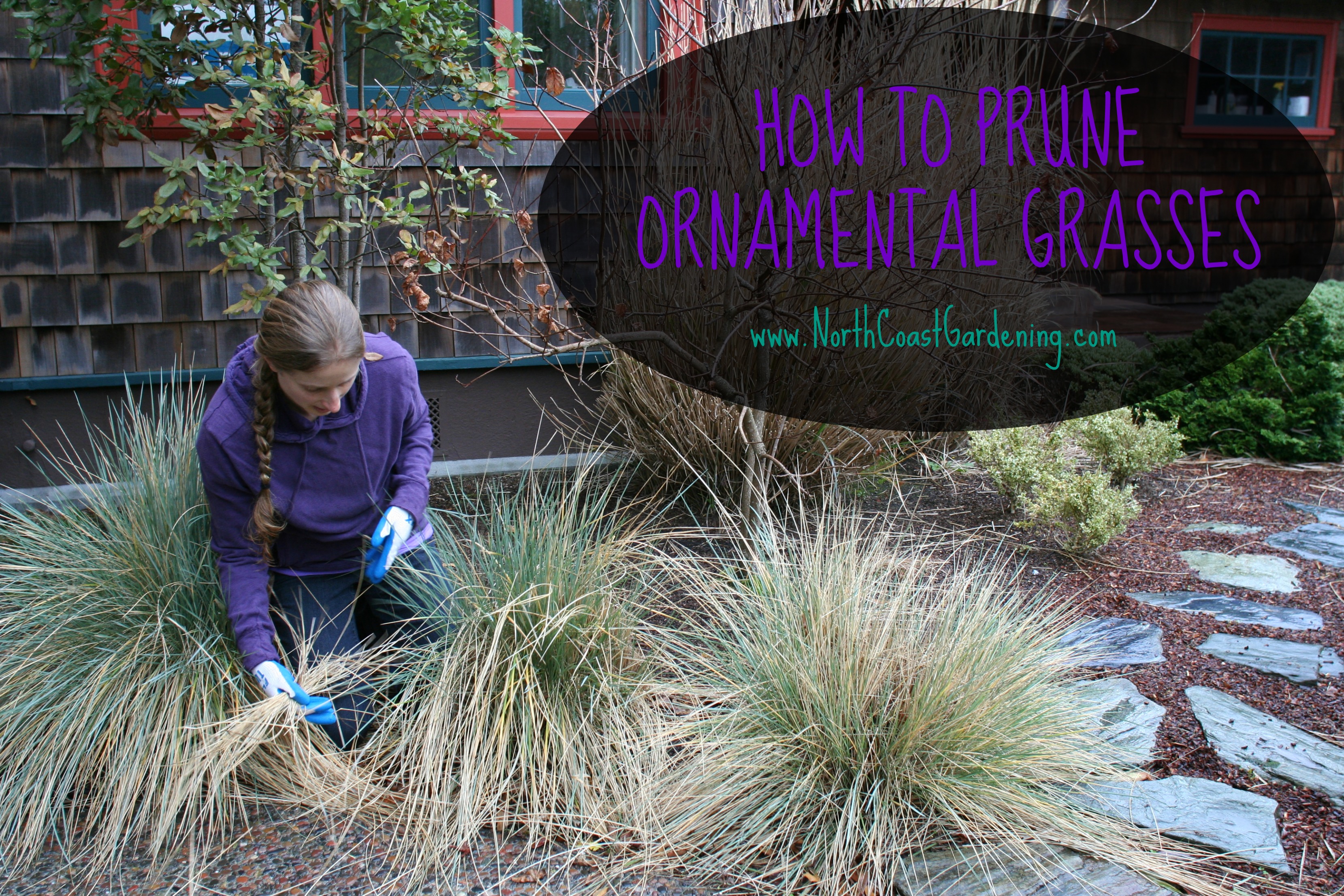
Most of us know what to do with our big grasses that go dormant each winter: Grab a bungee cord, tie the grass up, and use an electric hedge trimmer to buzz the column of foliage to the ground. But what about those tricky grasses that are evergreen or ones that have a ground-hugging habit? When and how do you prune those garden staples that don’t fit neatly into the “large and goes dormant” category?
If you are hesitant to treat your sedge the same as your maiden grass, it’s for good reason. Unconventional grassy plants can’t be trimmed using generalized pruning rules. They require special timing and techniques on your part to look their best. Start by figuring out which category your grasses fall under: evergreen or goes dormant, large or small. This allows you to select the best pruning method, even if you are not sure of the exact varieties you have.
Small and goes dormant
What: Japanese forest grass (Hakonechloa), Japanese blood grass (Imperata cylindrica), switch grass (Panicum), fountain grass (Pennisetum)
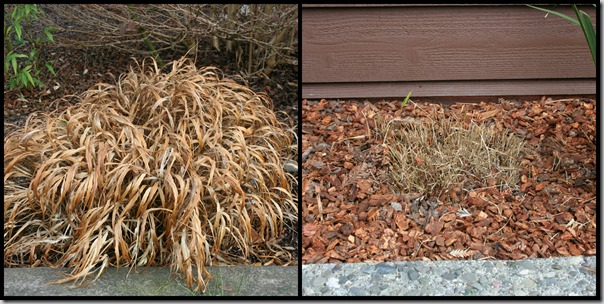 Photo: Before and after pruning Japanese forest grass
Photo: Before and after pruning Japanese forest grass
When: Yearly, late fall to mid-spring
How: If you like to prune, these short, spreading grasses are satisfying to tackle. Though you can prune any time after they go brown, hold off on cutting these grasses back as long as possible. Even brown, they provide winter interest and act as sculptural sentinels when covered in snow. If you clean up too quickly, you miss a lot of winter beauty. Birds also love to pack and scratch at the seeds in late winter when food is harder to come by.
Depending on your weather though, at a certain point these grasses will start to crumple and look thoroughly messy. When that time comes, use hedging shears to cut these grasses back to a height of 3 inches for the smallest selections – those that are under 3 feet tall, and to 6 inches for taller varieties – those that are over 3 feet tall. If you cut too low, you could be in danger of cutting into the crown of the plant. Moisture then tends to settle into the crowns and rots them out.
While some of these grasses have obvious growth points at the base and can be cut a little lower, others form rounded clumps – and it’s not always clear when you are in danger of cutting into the body of the crown. It’s good to leave a couple inches of leeway and not cut directly next to the growth points so that dew or frost settles a couple inches away from the crown. When I cut too close to the crown, I usually lose a few clumps throughout the plant and need to pull out the rotten bits a couple of months into the season. Pruning should be done every year to give the new foliage a clean slate from which to shine.
Large and goes dormant
What: Maiden grass (Miscanthus), feather reed grass (Calamagrostis), Giant pheasant’s tail grass (Stipa gigantea)
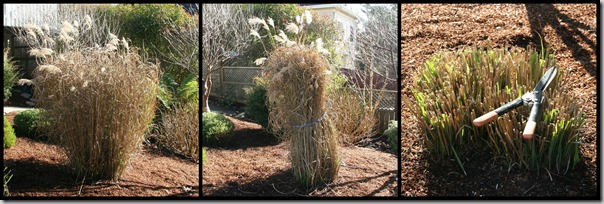 Photo: Before, during, and after pruning Miscanthus
Photo: Before, during, and after pruning Miscanthus
While pruning large grasses that go dormant is a similar process to pruning small ones, there’s something about having a huge mass of foliage towering over your head that makes it seem like a more intimidating task. Plus, bigger grasses can have sharp leaf blades, so if you prune without preparing you can get dozens of tiny stinging cuts on your face and arms.
When: Yearly, late fall to mid-spring Just like with small dormant grasses, it’s best to hold off on pruning as long as possible to preserve the winter interest and to provide food for birds. You can prune anytime after the plants go fully brown, as long as you do so before they start growing again in spring (you don’t want to nip the fresh new growth tips). The grasses themselves will give you your cue. Maiden grasses start shedding soon after the new year, so as soon as you notice them making a mess, it’s time to prune.
How: Even if you choose a sunny day to prune, wear a long-sleeved shirt and gloves so the blades of grass don’t cut your skin. Start by wrapping a piece of rope around the outside of the grass and tie it into a tight column of foliage. This way, the grass will stay bundled as you prune and not explode into pieces everywhere. Once your grass is tied up, use handheld or powered hedging shears to cut the entire grass to about 10 inches tall. If you’re using powered hedging shears, it’s helpful to have a friend hold up the grass so it doesn’t fall on you as you cut. Just be careful not to trim anyone’s ankles!
Though small grasses are easy to clean up, big grasses make a big mess. Plan to put down a fresh layer of mulch after you’re done pruning. This covers any tiny bits of grass that won’t rake up. (More on pruning Miscanthus here and here.)
Small and stays evergreen
What: Sedge (Carex), sweet flag (Acorus), blue oat grass (Helictotrichon), Mexican feather grass (Nassella tenuissima), lily turf (Liriope), mondo grass (Ophiopogon)
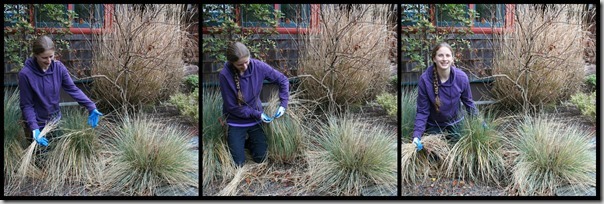
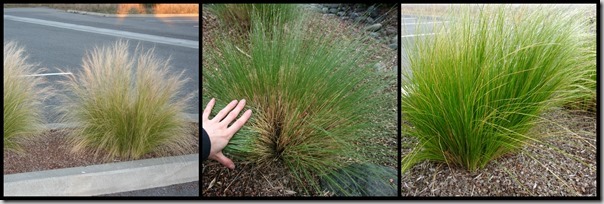 Top: Getting the brown blades out of blue oat grass Bottom: Mexican feather grass before, a month after, and three months after pruning
Top: Getting the brown blades out of blue oat grass Bottom: Mexican feather grass before, a month after, and three months after pruning
These little charmers are some of the easiest plants to tuck into your garden, because they fit almost anywhere, have year-round good looks, and need little care. Yet even the most easy-going of grasses need periodic attention to perform their best.
When: any time for cleanup, early to mid-spring for rejuvenation
How: By the end of the growing season, brown foliage can pile up inside these plants and give them an unkempt appearance. Luckily, there’s an easy fix to clean them up: just put on some rubber gloves (cheap dishwashing gloves work great) and run your fingers through the grass as though you were combing its hair. The spent foliage clings to the rubber and comes out in easy clumps. You may not be able to clean out all the spent blades, but removing some will trigger the grass to refresh itself.
Sometimes, of course, a stronger solution is needed. If painters have trampled on your evergreen grasses or if wind or winter cold have damaged even the freshest leaves, it may be time to go in for the big chop. In early to mid-spring, use your hand pruners or hedging shears to reduce the height of your grasses by two-thirds. While this leaves your grasses looking like awkward hedgehogs, these grasses bounce back fairly quickly and usually look good again in 2 to 3 months.
Cutting these grasses back too much will allow moisture to gather on their crowns, which can cause rot. When I’ve experimented with cutting back more than two thirds, portions of the grass died a soggy death. If you’re overly zealous with the pruners, you could also cut into the growth points on the crowns without knowing it – especially on sedges, which can form a mounded crown.
Rejuvenation pruning shouldn’t be done more than every 2 to 3 years because small evergreen grasses have slightly less vigor than grasses that go dormant. When you cut off all that foliage, the plant is losing energy stored in its leaves, so it ends up with less energy to put into producing new growth. I like to give the grasses time to recover before subjecting them again to a stern pruning. The exception is Mexican feather grass, which can be pruned back hard any time its foliage clumps into unsightly dreadlocks:
Large and stays evergreen
What: Flax (Phormium), Cordyline (Cordyline), Yucca (Yucca)
 Photo: Before, during and after pruning a Phormium/ flax
Photo: Before, during and after pruning a Phormium/ flax
Although technically not “grasses”, these large, spiky plants stand as focal points in the landscape, drawing attention with their bold colors in dramatic shapes. This makes it all the more important to prune right, because a poor pruning job will be noticed by everyone. Unlike with large deciduous grasses which are whacked back almost to the ground, subtlety is key when pruning large evergreen “grasses”. There are many reasons to prune these plants, ranging from the removal of dead flowers and ratty leaves, to keeping plants in scale with their surroundings. With brightly colored flax, there’s another reason to prune: The new growth is more brilliantly-colored.
When: Anytime for cleanup and resizing; mid-spring for rejuvenation
How: When pruning to freshen up foliage, I simply select the oldest or most damaged leaves and cut them out at the base. This might seem like a time-consuming task, but once you get into a rhythm, it goes pretty quickly. Use the same technique to prune for size. Grasp the tallest leaves, and one by one, cut them out as far down towards the base of the plant as possible. When pruning for size, move around the plant as you go, removing up to two thirds of the leaves, which is the point at which the pruning becomes obvious.
Sometimes, however, selective pruning just doesn’t cut it. If your plant is overgrown, has significant winter damage, or must be cut to make room for construction, you can prune severely in mid-spring. Use hedging shears to cut off all the foliage at the base. You’ll end up with a mound about 1 foot tall. While cutting off all the foliage is not an ideal approach, these varieties grow back quickly and look good again in about four months. They do, however, have an awkward phase during their regrowth: When the blades start to regrow, some will look damaged and have clipped tips, so you’ll need to selectively prune again to remove those. This allows the fresh new growth to shine.
Over time, some varieties of Yucca and Cordyline grow quite tall and develop a long trunk. If you don’t want yours to look like a tree from a Dr. Seuss story book, cut the plant midway down the stem; it should pre-sprout from just under the cut point. In areas where these plants are marginally hardy, however, cut the trunk back by only one third. Sometimes that stem will re-sprout, but occasionally, the plant will sprout up from the base, instead. One last caveat: Be sure to wear eye protection any time you are pruning spiky grass-like plants. When you are focusing on removing leaves at the base, it’s easy to lean down and get stabbed in the eyeball with a sharp leaf tip. That’s a definite pruning “don’t”.
(Article originally appeared in Fine Gardening Magazine)
46 responses to “Stop! Don’t Prune That Grass (How to Prune Ornamental Grasses Right)”
oh-my-goodness-Jen – This is so helpful. All the answers in one place. I’m bookmarking this one!
Awww, thank you so very much Lauren! Much appreciated. . .
Read your review on the Fiskar 6201 and found your web site. Thank you for both the review and Grass plant care. It was very helpful and I am going to acquire the 6201 reel mower. We live in Canada so our season is short, but the lawn and grasses still need attention.
Ken, thank you so much for your kind words! I love my Fiskars mower and glad you will have the chance to use one, too!
This is great info. I have a question you might be able to answer. I live on long island, ny and transplanted an ornamental grass (not sure of the exact type). I dug it up, split in 2 and then replanted in a dif spot. I used potting mix with fertilizer. The problem is that the leaves are now wilted. I am not sure if I killed the plant or should leave it. I am wondering if it will regrow or not. Please let me know what you think. Thanks!!!!
Hi Barbara,
I had the same problem last year living in CT, used potting mix also.
Potting mix fertilizer contains nitrogen which is good, but causes the plant to go limp thru the growing season.
The grass will come back next year straight and tall avoid over fertilizing.
Cheers, Craig
I have a HUGE NZ Flax in my very small UK garden – it was planted 3 years ago, and has now virtually taken over the raised bed – if I cut it right down in the autumn, will it grow again in the spring?
Liz, maybe best to wait until after last frost in spring, They can be tender!
Geneivere,
Great page answered all my questions !
I have a new 5 acre property on Vancouver Island, BC and have planted many new grasses. Can I leave them un-pruned till late April? I want them to get established.They’re very small right now.
Yep. Pruning isn’t a requirement, it just helps them look good. I agree with you to skip it this year.
Excellent tips on a topic I’ve been trying to find good information on! Thanks for these – Pinned!
[…] 24. Stop! Don’t Prune That Grass (How to Prune Ornamental Grasses Right) | North Coast Gardening “Unconventional grassy plants can’t be trimmed using generalized pruning rules. They require special timing and techniques on your part to look their best…” […]
Very nice post! Exactly what I was searching for! Thanks!
I’m so glad to get this info on the ornamental grasses! I moved four 2 ft. in diameter clumps of Pampas grass to our new home this year. My husband had cut it about 6″ from the ground prior to moving. After reading this, I’m thinking he must have gotten past the crown because most of it died out. Some of it grew back, so maybe I’ll have large, beautiful plants once again someday. I’ll have to inform my hubby of this!
I’m heading into you other subjects. I’m so glad to have stumbled onto your site! My flowers thank you!!!
[…] Stop! Don’t prune that grass (How to prune ornamental grasses right) […]
My company was cleaning up the landscape of one of their buildings. I grabbed the huge ornamental grasses they were throwing away. Unfortunately the landscapers had to pry the roots apart to make them transportable. It was late spring early summer. I planted them where they get late afternoon sun. They still have some green shoots and holding on. Do they have a chance to survive? They look a little sad.
Hi Geneivere
Thank you so much for your article. As a NEW home owner in Vancouver, BC I realize I need as much help as possible with my grasses. My question is I have a variegated ornamental grass (stays green year round, sedge??) transplanted late last spring. There were some brown leaves within it but thought best to leave them for time being. It seems to be doing well. I’ve notice it’s already spreading this spring. But I’ve still got several brown leaves within it. I can see many of them have green bases and some are brown right to the root. It’s quite thick, about 18″ tall and the same in width. Do you have any suggestions?
Any assistance would be greatly appreciated!
Thanks is advance.
Danielle
So helpful, thanks! I am wondering…when will I know if my zebra grasses made it through the winter? I’m not seeing any new shoot! I have been growing ornamental’s of all types for years, but last summer was my first planting of zebra grass. They took off and did great and feathered out. I kept them moist through the fall and the winter was pretty mild by midwest standards. My pompus and feather reed grasses are doing great but no sign yet of live on the zebra. (oh, and my beautiful lemon grass looks dead too!) Any ideas?
I live in the Southeast of England not far from London. We planted a Pampus Grass about 10 years ago, & have it pruned every year by a gardener, last year he only pruned it to about 4ft high & it is about 4ft wide. I’ve noticed it looks dead in the middle with new growth around the outer edge,What is wrong? I would hate to loose this specimen, it has been beautiful over the years, please help!
I have 6 golden sedge grasses in pots all 6 have gone brown on the ends how can I solve the problem
I am a Ghanaian and have read a lot on your responses to the questions asked across the globe concerning landscape designing. I have the desire to know more about landscape designing to enable me practice more in my country. In Ghana, I have established a small gardening at my rented apartment and would want to know some of the principles of lawns and landscape in order to contribute more to my country.
Thank you.
Reading blogs around the world is a great first step in that. Good luck!
Jen,
Thank you for comprehensive information. Most times you can’t find the detail for all the different types of grass.
Amazing!!!!!
Very informative article, Thank you.
I have planted carex pansa as a replacement for my rather large lawn. Last month I mowed it as it was about 15″ high and well filled in. (we planted 6000 2″ seedlings about 10″ on center). The problem is now the plants are sending out runners, a lot of runners, very deep runners into the surrounding planting areas. Is there any way to stop or slow the runners short of removing the carex?
Interesting article. Do you have any suggestion for how to care for “Calamagrostis foliosa” (leafy reed grass)? Should I cut it and when? It is about 7 years old and is spreading. I would like to keep it in small bunches.
HOW DO YOU FEEL ABOUT BURNING THE SEA GRASS WITH A TORCH AFTER IT HAS GONE TOTALLY DORMANT??? ACCIDENTALLY DID IT TO ONE SEA GRASS BUSH ONE YEAR AND IT CAME BACK REMARKABLY BETTER THAN ALL MY OTHERS. CRAZY?????
No clue. I am intrigued!
At the golf course where I play, there are many beautiful tall Fountain grasses. At the end of the fall, they cut them down and then sprinkle some gasoline on them and burn them. I know this sounds crazy but the grasses come back in the spring with a flourish. Can’t believe the gasoline doesn’t kill the roots or at least cause damage. I don’t do this and wouldn’t recommend anyone setting fire to any plant (especially close to a home) but this is a practice that is used at my course and others have told me they do it on their own grasses at their homes.
So if I am interpreting the information correctly if I trim up my monkey grass on July 4 southeastern PA USA I will probably kill it? It is a little wild and I was thinking it would be good to get it under control
I transplanted some grass and all the grass turned brown and died. I have new shoots coming in the bottoms and was watering Dailey . Should I trim them now or wait till fall and because they look dry I’m watering daily is this a no no? I wish I could attach a picture.
Great article! I have been trying to teach gardeners the same thing around here. Grasses don’t need to be cut back every year. It stresses the plant. I have a little, very stiff rake that I use to de-thatch deer grass and blue oat grass. I’m going to try the rubber gloves out and see if it gets more.
We live in Southeastern Wisconsin & have beautiful varieties of tall grasses next to our driveway, some or all of which need to be cut down in Fall for snow blowing.
They’re all very well established for years. How far down can we shorten all of them?
We also have a lot of green & white bamboo grasses that continue to spread. Last Fall we didn’t cut them back for Winter, as they’re shorter, and they’,e thrived.
Should bamboo grasses be cut back too?
This is awesome. Thank you, this is hard information to find 🙂
You are a brilliant gardener! I used to live in Fortuna but now live in Chico, CA. Is there a site I could go on and find all the wonderful plant information and instructions for this hot climate, zone 9 ? — Thank you so much for any help you can give me.
Excellent posting! Thank you! I have a question regarding the Maiden Grass. I moved into a home with a lot of these plants. Problem is that it looks like the owner has not pruned these bushes back for a couple of years and now they are an out of control brown and green messes! It is an eyesore for the neighborhood and I want to clean them up. I feel like the cleanest thing to do would be to cut them all down now, even though it is normally done in late winter. It is safe to trim them all down now so I can get in there and clean up the beds and then trim whatever growth occurs in late winter to get them on the right cycle? Help!
First, loved your article, very informative. Second, I prune in late fall, after pruning I do not get rid of my grass right away. Before pruning, I divide the grass into sections and use (Christmas) curling ribbon to tie around the lower sections. Then I just cut off at the bottom. This way I don’t have single blades of grass blowing all around, plus I then take the sections and lay them out on my driveway to dry for a few days. After dried I arrange the sections around my lamp post & porch railings and just use the curling ribbon to attach. I also do the same thing with my Hydrangea tree flowers and add them. After attaching an attractive ribbon I now have my Halloween, Thanksgiving and Christmas outside decorations in place!!! I just change out the ribbons, add some silk mums and pointsettia and it looks great for several months. Around February I just remove from posts and lay out for trash collection since they are still nicely bundled. Saves time, money and recycles.
I live in Twin Cities, MN. I have large hydrangeas and very tall irises. When is the best time to cut them down this fall?
I live in Southern-Ontario, Canada, and have a thick-leafed, thick-stocked, no flowers, two-foot tall Ornamental grass. I don’t know what it is. I would like to dig it up and bring it into the house, for decoration, but I don’t know if that is possible. It looks like the thick leafed photos in this Site. Can I bring it in the house, for ever, or is it an Annual, and will just die when the Frost hits it?
Thanks!
I have had Zebra grass planted in an area for over ten years. I follow your instructions for pruning, but have an issue with the mound. New grasses come up around the mound but just a few in the middle. That area seems to be choked tightly enough that the new sprouts don’t seem to be able to push through. Suggestions?
I recently moved to central Florida, and I am in need of advice as to which grasses are best suited for the sandy soil and al the Summer rains.
Can u this grass near your house?I heard it will crack your fountain of your house ?
Thank you as a gardener I love to hear proper advice. So tired of what I call the pillar of death prune(Take off green outside leave dead core, then wonder why plant fades out after couple of years) So you teach someone a proper rejuvenation cut and they end up doing it twice a year. Sorry just venting thanks again
Hi – my 1 maiden grass is in 24″ pot and came back 3 times. I always trim flat across as you demo’ed, once brown, in about late Nov/early Dec. This spring, the cut portion is still brown (June) and has not yet sprouted new growth. Is it still dormant, or is it dead? THANKS – Brooklyn, NY
Your breakdown is excellent, but I still don’t know what to do with my pampas plants, which are evergreen. They provide great privacy and block road dust, but they are also blocking the water supply. Is there a way to go in and just thin them???? Wish I would have read the part about wearing protection before I got started!!! Thank you!
I just planted white and red fountain grass in zone 10. It’s Mid January and the temp hit 50 this morning in Stuart, FL. That about does it for us and it will average almost 70 for the next 2-3 months.
Is it ok to trim some dead stuff that occurred as a result of the transplant or should I wait for the plants to take root? Thanks